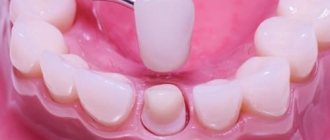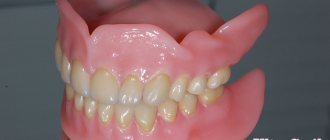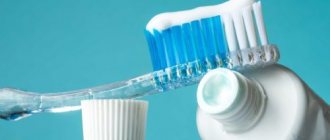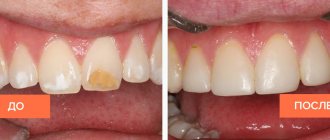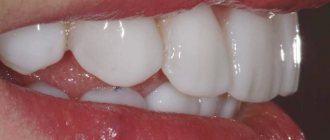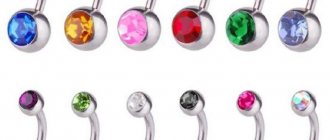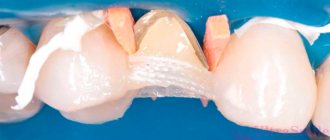The Smile-at-Once clinic uses new generation composites - increased strength using nanoparticles. Despite the fact that they are stronger than classical materials, the patient in any case needs to follow the rules for caring for the extended teeth.
Extensions are very similar to regular fillings, since the same materials are used. Therefore, the rules of care are largely similar. However, there are also differences - artistic restoration is carried out in a more elaborate manner, since a small piece or even a whole crown is built up. The composite is fixed on top, and not placed inside the cavity, so the absence of walls imposes certain obligations in terms of caring for such teeth.
How much should you not eat after teeth extensions?
Since anesthesia is used for recovery, you should avoid eating for 2-3 hours after the end of treatment. You need to wait until the numbness goes away completely, otherwise you may accidentally bite your lip, tongue or cheek while chewing.
Modern photopolymer dental fillings harden under the influence of a special lamp almost instantly, so the load on them will not lead to shrinkage of the material - if anesthesia was not used, you can eat right away. But it is better to give preference to softer and warmer foods.
If the tooth has been significantly damaged and a pin or stump insert was used as additional support, you should avoid eating hot or very cold food for the first 24 hours, since special dental cement was used - its fixing properties may become worse under temperature stress.
Contraindications to the procedure
In some cases, you have to postpone it for a certain time or completely abandon this idea. Restrictions can be temporary or absolute. The first includes:
- insufficient level of oral hygiene;
- inflammatory processes;
- periodontal diseases;
- malocclusion;
- significant destruction of the dental unit;
- diseases of the jaw joint.
These shortcomings can be eliminated. The presence of metal-ceramic crowns at the site of the proposed restoration completely rejects the idea of restoration with a composite or ceramic, since these materials are incompatible, and the result of the efforts will be short-lived. Also, dentists at the Dentika clinic do not recommend installing veneers and lumineers for bruxism and pathological tooth wear.
What dietary restrictions are there after dental restoration?
Modern composites, even despite their high performance characteristics, are susceptible to staining, which is why even if the filling is in good condition, after a few years it becomes darker compared to natural enamel. Over time, a clear contrast will be felt between the living tooth and the extended piece.
Extended teeth are quite weak - under load, a piece of filling material can break off. Especially when carrying out restoration of the frontal zone. All this requires following a certain diet.
- coffee, tea, red wine, sweet colored soda, beets, sauces (especially tomato and soy), berries, candies and caramel are not recommended - that is, all products that over time will lead to a change in the shade of the extension,
- Avoid eating solid vegetables and fruits whole - it is better to cut them into pieces and chew them with unextended teeth. This is especially true if the front teeth have been restored - they should not bite off hard foods, gnaw seeds,
- give up the habit of cracking nuts or cracking seeds, gnawing crackers with extended teeth,
- Chew food slowly, especially if it is hard or fibrous,
- Avoid food that is too hot or cold - it can cause cracks and chips in the material.
If women have extended front teeth, it is better to avoid bright lipsticks, since composites can again become stained.
Advantages and disadvantages of dental extensions
In dentistry, various methods are used to restore lost tooth fragments, but for most patients, doctors recommend paying attention to tooth extensions. This is due to the numerous advantages of the procedure:
- A large selection of technologies and materials allows you to choose the optimal solution for each person and restore both front and back teeth.
- Highly aesthetic results.
- The restoration does not affect neighboring (healthy) units, does not increase the chewing load, that is, it protects the dentition from accelerated wear and destruction.
- Minimal trauma: oral tissues heal quickly without causing significant discomfort to the patient.
- The materials used during extensions are durable, aesthetically pleasing, do not change color and strength during use.
Dental extensions have virtually no disadvantages. The only drawback is the fairly high cost of services, but it can be adjusted by choosing simpler restoration methods and more affordable materials.
How to do oral hygiene
If it is impossible to refuse drinks and foods that stain filling materials, you need to pay increased attention to hygiene. In such situations, cleaning after every meal is mandatory.
- cleaning in the morning and evening (before and after breakfast, as well as after the last meal) with a medium-hard brush,
- irrigator, dental floss, brushes and rinse for cleaning the interdental spaces after each meal and even after a regular snack.
Composite veneers: installation method, advantages, indications
Composite veneers are the second name for aesthetic dental restoration performed using modern microphilic compounds. The doctor applies the filling material to the surface of the damaged or defective tooth and creates the ideal anatomical shape of the unit immediately in the patient’s mouth. After polishing, the restored tooth is indistinguishable from neighboring incisors and canines.
Since real-time tooth restoration requires high professionalism and experience from the dentist, it is necessary to look for doctors who have been involved in artistic restoration with composite materials for a long time. The best selection criterion will be patient reviews and independent rating indicators.
When are composite veneers recommended?
Indications for restoration with filling material are determined by the properties of the compositions used - strength characteristics and durability indicators. The aesthetics of the tooth can be easily restored in cases of minor changes in the shape, shade or position of the anterior units:
- Small chips along the edges.
- Moderate-sized interdental gaps.
- Teeth extension with physiological abrasion.
- Change in enamel color.
In other cases, the use of classic indirect veneering or the installation of ceramic crowns is indicated.
Does the restoration need to be changed and when might it be necessary?
On average, the service life of composite extensions is about 3-5 years. Such a filling may last longer, but it will stand out on the front teeth after 3-4 years. Composites shrink, albeit slightly, so over time a small step will appear between the tooth and the filling material. This is especially noticeable on the front teeth if they are partially restored. In such a situation, you can update the restoration, that is, completely grind it down and replace it with a new one. Or simply re-build it up with a composite on top - in certain situations this is also allowed.
Dental restoration methods
The direct method is the application of a light-curing composite material. The doctor forms a layer, illuminates it with a UV lamp, and so on until he completely restores the shape of the tooth. A rich palette allows you to choose the shade of the composite to match the natural tone of your teeth. Finally, sanding is carried out. The restoration will last up to 5-7 years.
The indirect method is the use of veneers or crowns for chewing teeth. They are made in a dental laboratory from ceramic masses and metal or zirconium frames. Service life – 10-15 years.
Types of bone grafting
The dentist-implantologist has several methods at his disposal to effectively restore bone volume, and their choice depends on the nature of the deficiency. In this case, we mean a vertical or horizontal tissue deficiency, that is, an expansion of the narrow alveolar process or an increase in its height to install an implant. The following innovations are recognized as the most popular among dental implantologists:
- implantation of bone tissue of biological or synthetic origin;
- expansion of the alveolar part of the bones of the upper jaw;
- targeted bone regeneration with the installation of a specific membrane;
- For bone tissue atrophy in the marginal areas of the upper jaw, a sinus lift is used.
Each of these methods has its own advantages, however, like any other intervention in the body, there are significant disadvantages of bone grafting of any kind. The most important disadvantage of this manipulation is considered to be a large time investment, that is, the process of restoring the required volume of bone tissue can reach 6-7 months. Another disadvantage of the maxillofacial reconstruction process is the cost of the procedure, and only wealthy people can afford professional dental implantation.
Composite materials for restorations
Performing direct artistic restoration requires the use of reliable, color-stable and durable materials that cannot be erased.
Due to their excellent characteristics, light-curing composite materials are used in dentistry. Photocomposites have excellent adhesion to dental tissue at the molecular level and do not change their position due to the ability to diffuse into enamel and dentin, and at the same time they do not violate the aesthetic perception of the tooth. These materials are applied in very thin layers to compensate for shrinkage due to photopolymerization. If the application technology is followed, a long-term, consistently high-quality effect is achieved.
To most accurately match the material to the mechanical characteristics of the tooth and its color (everyone’s teeth are individual), dentists layer materials of different shades and properties on top of each other. The result is a complete imitation of high-strength translucent enamel.
The strength of photocomposites allows them to be used in the restoration of anterior and chewing teeth that receive maximum load. Many of these materials contain fluoride ions, which helps prevent the development of secondary caries over the entire surface of the filling.
When restoring teeth of irregular shape, their visual contour is often corrected, the corners are smoothed or, on the contrary, sharpened, giving an individual uniqueness to the smile.
The advantage of direct restoration is that all the work will be done in one visit to the dentist (2-6 hours). Modern materials are suitable for closing gaps between teeth, changing their shape, size and color.
Pros and cons of direct veneers
- The main advantage of composite veneers over ceramic ones is, first of all, price. Composite veneers do not require complex installation technology and expensive materials, so prices in aesthetic dentistry are low.
- Another benefit of composite overlays is the time it takes to install them. Therapeutic veneering is possible in one visit, as it does not require taking impressions and making plates in a dental laboratory. But this advantage is not always relevant, since technologies have appeared that make it possible to install ceramic veneers in one day.
- Reviews of the installation of composite veneers indicate that they cope well with irregularities, chips, cracks and large gaps between teeth, but they do not imitate the natural color and transparency of enamel as perfectly as ceramic ones.
- The main disadvantage of composite veneers is their imprecise fit to the tooth surface, which is why plaque and bacteria accumulate in border areas, increasing the risk of caries and gum inflammation.
- The doctor is required to have aesthetic taste and excellent skill, otherwise the result will not live up to expectations.
To whom is the technique contraindicated?
Artistic restoration of teeth with composite material is not possible for all clients, since the technique has a number of contraindications (some of them are temporary and correctable):
- Allergic reaction to the composite;
- Installed pacemaker;
- Some individual characteristics that prevent the sealing of a carious cavity;
- Poor oral hygiene;
- Night grinding of teeth (bruxism);
- Pathological bite;
- Excessive abrasion of tooth enamel;
- Frequent stay in traumatic conditions (athletes, rescuers, etc.).
By registering with Nurimed, clients can be calm about their own safety and the results of the procedure, since the clinic’s doctors individually assess the risks and benefits for everyone.
Extension of chewing teeth
Chewing teeth are also often subject to destruction, in most cases the cause is caries. After treatment of caries, especially deep ones, large cavities remain, which the specialist fills with filling material after treatment. However, in some cases, only the root and a few thin walls may remain from the tooth, and sometimes even these remain. However, one of the trends in modern dentistry is the use of maximally tooth-preserving techniques. Therefore, if previously a healthy root that had lost its coronal part would most likely have been removed and a bridge-like prosthesis installed instead of the tooth, or, at best, an implant, today they prefer to preserve the root and restore the coronal part by installing an inlay and a crown.
